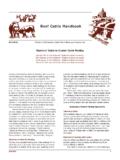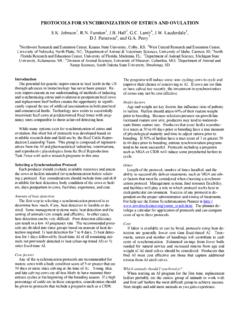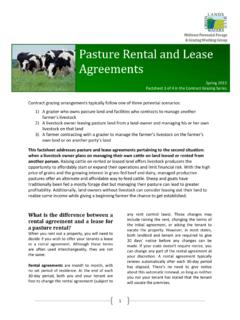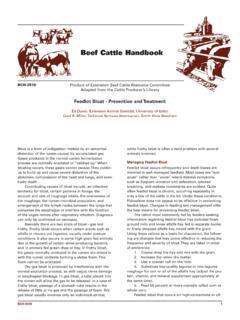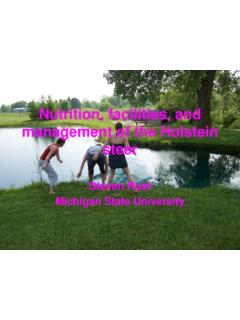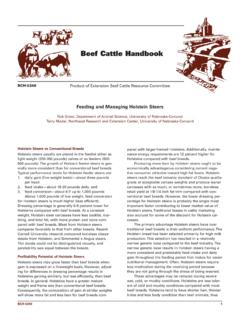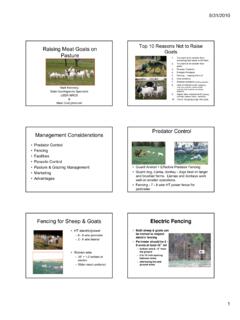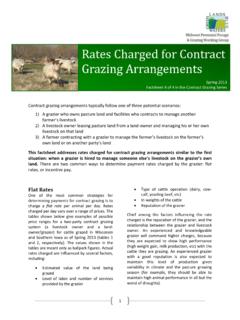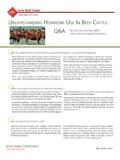Transcription of Winter Cow Feeding Strategies - Iowa Beef Center
1 2/12/13%. Winter Cow Feeding Strategies Travis Meteer Beef Extension Educator University of Illinois Why is this Important? Feed Costs represent over 60% of the total costs in a cow-calf production system and are the largest determinant of profitability for beef producers . (Miller, et al., 2001). 1%. 2/12/13%. Why is this Important? Its not about marketing this year, its production challenges . (Derrell Peel, Fall 2012). Objective Identify proven Feeding Strategies that can save YOU money Discuss pro's and con's of Feeding Strategies Ideal: Feeding cheap feeds, with no waste, that meet cow requirements, and do not cause negative side-effects. They are easy to handle and require little equipment, facility, and labor investment.
2 2%. 2/12/13%. Outline Set the stage Feeding Hay Extending the grazing season Cornstalks Corn Silage Feed Additives Set the Stage 3%. 2/12/13%. Profit Robbers . BCS 4. 4%. 2/12/13%. BCS 5. BCS 6 - ideal 5%. 2/12/13%. Feeding Hay Feeding Hay Considered SOP (Standard Operating Procedure). Important to realize: Average to high cost High waste May or may not meet cow requirements No big negative side-effects. Very easy to handle Low equipment, facility, and labor investment 6%. 2/12/13%. Hay Waste Hay waste occurs during Baling, Storage, Feeding Bale Storage Outside Ground - 5-20% loss Elevated - 3-15% loss Covered Ground - 5-10% loss Elevated - 2-4 % loss Under Roof - 2-5 % loss Enclosed Barn - < 2% loss 7%.
3 2/12/13%. Feeding Hay Must have high quality to meet needs EXPENSIVE $$$$$. Alfalfa - Good: $220/T. Mixed - Good: $180/T. Grass - Good: $165/T. Grass - Utility: $130/T USDA Market Report (Jan 2013). -Northern IL, big rounds Average to poor quality hay Needs supplementation Limit Feeding Hay 8%. 2/12/13%. Limit Feeding Hay 72 Simmental Cows (~ 1250 lb.). 2nd and 3rd trimester 4 Treatments of time restriction 1) 24 hours/day 2) 9 hours/day 3) 6 hours/day 4) 3 hours/day 9%. 2/12/13%. Diet Composition Diet consisted of large round bales of alfalfa hay stored inside CP ADF NDF RFV 125. Hay Disappearance 40. 35. 30. 25. Lbs hay Waste 20. Intake 15. 10. 5. 0. 3 Hours 6 Hours 9 Hours 24 Hours 10%.
4 2/12/13%. Hay Waste Costs $ Dollars/ day*. 1. $.72. 0. 3 Hours 6 Hours 9 Hours 24 Hours *Hay price: $185/ton Bale Feeders Waste Trailer Cone Ring Cradle Buskirk, MSU. 11%. 2/12/13%. Bale Feeders Waste David Lalman OSU, Robert Wells, Noble Extend the Grazing Season 12%. 2/12/13%. Extending the Grazing Season Management Intensive Grazing (MIG). Alternative Forages Cornstalk Grazing Corn Residue 13%. 2/12/13%. Utilizing Corn Residue Utilizing Corn Residue Not new, but new methods used. Some past poor experiences Important to realize: Low cost Variable waste May or may not meet cow requirements No big negative side-effects. Generally easy to handle Average equipment, facility, and labor investment 14%.
5 2/12/13%. Composition of Corn Residue % Dry Matter Total Digestible Nutrients (TDN) 54. Crude Protein 5. Neutral Detergent Fiber (NDF) 70. Calcium Phosphorus Source: Feed Composition Tables, Beef Magazine. UNL Cornstalk Grazing 5 yr. study to evaluate supplementing stalks Supplemented with a DDGS based cake 25% CP. 7% fat October- weaning, start on stalks February- off stalks, pre-calving May- pre-breeding Warner, 2012 UNL Beef Report 15%. 2/12/13%. Warner, 2012 UNL Beef Report Dudley Smith Project Cornstalk Grazing and Supplementation 16%. 2/12/13%. Objectives of DSI Project Maximize production per acre Harvest corn grain Utilize DDGS and corn residue for cattle Compare stocking rates 1 cow / acre vs.
6 Cows / acre Compare strip-grazing management Move fence every week or every other week DDGS / Crop Residue Treatments (All cows fed 4 lbs DDGS). 1 cow / acre (fence moved every 2 weeks). 24 acres divided into 3 strips 2 replications (24 cows each). cows / acre (fence moved every 2 weeks). 24 acres divided into 3 strips 2 replications (36 cows each). cows / acre (fence moved every week). 24 acres divided into 6 strips 2 replications (36 cows each). 17%. 2/12/13%. Cow Performance Results Item 1 cow /acre (2 wk) cows/ acre (2 wk) cows/ acre (1 wk). Initial BW, lbs 1260 1276 1272. Final BW, lbs 1343 1340 1318. BW Change, lbs 83 63 46. Initial BCS Final BCS BCS Change Economics Item 1 / acre (2 wk) / acre (2 wk) / acre (1 wk).
7 Corn stalks ($10/acre), $/hd/d $ $ $ DDGS ($275/ ton @ 4 lbs/hd/d) $ $ $ DDGS Feeding labora , $/hd/d $ $ $ ( hrs for all 192 hd). Fence moving labora , $/hd/d $ $ $ (20 minutes 2x or 5x). Total cost, $/hd/d $ $ $ a Labor @ $12/ hr +. 18%. 2/12/13%. GPS Tracking Cattle were tagged with GPS tracking collars Location was logged every 4 sec for 5 day period 2 days before and 3 days after fences were moved Dudley Smith Farm Water 2%weeks 2%weeks 2%weeks 4%weeks 4%weeks 4%weeks 8%. a cr 2200%E. e s 6%weeks 6%weeks 6%weeks Control 19%. 2/12/13%. GPS Tracking 0 2 weeks GPS Tracking 2 4 weeks 20%. 2/12/13%. GPS Tracking 4 6 weeks Hot-spot Analysis 2011/11/08 2011/11/11. 21%. 2/12/13%. Topography Impacts Cattle Movement What if you can't graze?
8 22%. 2/12/13%. Orr Center Trial Objectives To compare ad libitum hay diet to corn residue and DDGS diets Compare ad libitum corn residue bales and DDGS supplementation to mixed rations using high or low levels of ground corn residue and DDGS. Methods 164 Angus and Simmental Cows (16 pens). Trial started at calving Milk production determined at ~ 60 days Trial ended at time of AI. Cow DM disappearance, BW change, milk production, calf ADG, and AI conception 23%. 2/12/13%. Treatments Ad Lib: DDGS (~ lbs DM/d). ad libitum access to corn stalk residue bales High: DDGS (~ lbs DM/d). ground corn stalk residue (~ lbs DM/d) - TMR. Low: DDGS (~ lbs DM/d). ground corn stalk residue (~ lbs DM/d) - TMR.
9 Hay: (Control). Ad libitum access to good quality mixed alfalfa hay bales Feed Costs, $/d Prices: DDGS - $275 / ton, Hay- $210 / ton, Corn Residue $75 / ton 4. 3. 2 1. 0. Feed,Costs,,$/d Ad,Lib High Low Hay 24%. 2/12/13%. Are there other costs?? How will residue/ and or hay be stored? How will DDGS be stored (dry/wet)? How will corn residue be fed (grind/ ad lib)? Do you have bunks and concrete? Do you have a tub grinder or feed wagon? Feed and Delivery Costs, $/d 4. 3 2. 50,Cows,1,Wagon 50,Cows,1 100,Cows,1 100,Cows,1. Hand,(Ad,Lib) Wagon Hand,(Ad,Lib). Ad,Lib High Low Hay 25%. 2/12/13%. Feed and Delivery Costs, $/d 3. 2 150+Cows 200+Cows 250+Cows 300+Cows Ad+Lib High Low Hay Conclusions Feeding DDGS and corn residue resulted in Adequate or improved performance Reduced feed cost compared to traditional ad libitum hay diets fed in herds with 100 cows Ad libitum stalks are less expensive than grinding stalks and Feeding TMR.
10 Especially in small herds - DDGS can be hand fed Herd size, existing equipment and facilities will determine which system is best fit!!! 26%. 2/12/13%. Fall (Drought) Trial at Orr Treatment 1: QLF - CB. Ad lib access to cornstalk bales treated (20% bale wt.) with QLF liquid supplement blend Treatment 2: MIX 30. Ad lib access to cornstalk bales treated (20% bale wt.) with Mix 30 liquid supplement Treatment 3: CGF. Ad lib access to cornstalk bales and dry CGF. bucket fed (5 lbs/hd/d as-is) in concrete bunks Treatment 4: HAY. Control, Ad lib access to grass hay Fall (Drought) Trial at Orr 27%. 2/12/13%. Fall (Drought) Trial at Orr MIX 30 QLF-CB. Fall (Drought) Trial at Orr 28%. 2/12/13%.
